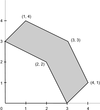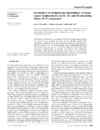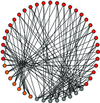issue contents
May 2012 issue

Cover illustration: The sequence of constructing the cartwheel pattern of the first-level hierarchy of the quasi-periodic pattern on the interior walls of the courtyard of the Madrasa of al-'Attarin (1323), Fez, Morocco [Al Ajlouni (2012). Acta Cryst. A68, 235-243].
research papers
Enumeration of one-dimensional crystal structures obtained from a minimum of diffraction intensities
The number of one-dimensional crystal structures that can be determined from a minimum of diffraction intensities is obtained here for the first time. This number increases exponentially with the increasing size of the structure, illustrating quantitatively the vast structure ambiguity caused by the lack of experimental phase information.
Mean-square displacements were computed within the harmonic approximation from ab initio force constants for binary B-, Tl- and Bi-containing III–V compounds with the sphalerite crystal structure in the temperature range from 0 to 1000 K. A fitting scheme based on an Einstein model with a temperature-dependent characteristic frequency was applied to describe the temperature dependence of the mean-square displacements. Respective fit parameters, phonon dispersion relations and densities of states are given.
Bayesian model comparison affords a reliable technique for distinguishing externally characterized minority populations from background noise.
A high-resolution study of (002, 113, 11−1) four-beam diffraction in Si was performed both experimentally and theoretically. Excellent coincidence between theory and experiment was achieved. The forbidden two-beam 002 reflection was excited with the maximum reflectivity of 80%.
The construction and application of the generalized ELMAM2 databank of experimentally derived aspherical atom types are described. With this new database, it is possible to transfer multipolar parameters to proteins and various organic molecules within the limitation of the currently available atom types.
Download citation


Download citation


The relative intensity (or rank) of a reflection is considered as an alternative metric when attempting structural refinement using precession electron diffraction data.
A model of polysynthetic Brazil twins in α-quartz with composition planes parallel to a face of the minor rhombohedron z is proposed. Density functional calculations show that the proposed twin boundary structure has very low energy.
Open  access
access
 access
accessA new algorithm is developed for reconstructing the high-resolution three-dimensional diffraction intensity function of a globular biological macromolecule from many quantum-noise-limited two-dimensional X-ray laser diffraction patterns, each for an unknown orientation. The structural resolution is expressed as a function of the incident X-ray intensity and quantities characterizing the target molecule.
The effects of thermal vibrations on X-ray powder diffraction patterns are discussed. Special considerations for extremely small crystallites are described.
The topological complexity of crystal structures can be characterized using complexity measures of their quotient graphs. Information-based complexity measures (topological information content, IG, and information content of the vertex-degree distribution of a graph, Ivd) are shown to be efficient for comparison of the topological complexity of polymorphs and chemically related structures.
short communications
The phasing equations of δ recycling direct methods are derived from the minimization of a residual between two differently calculated density functions (one of them including the positivity constraint).
international union of crystallography
Free 

book reviews
Free 

books received
Free 



 journal menu
journal menu

































